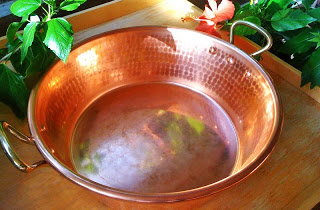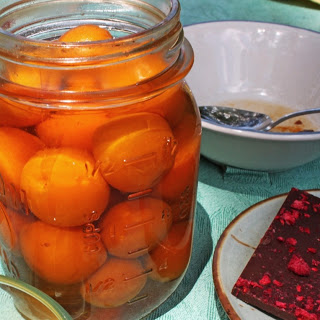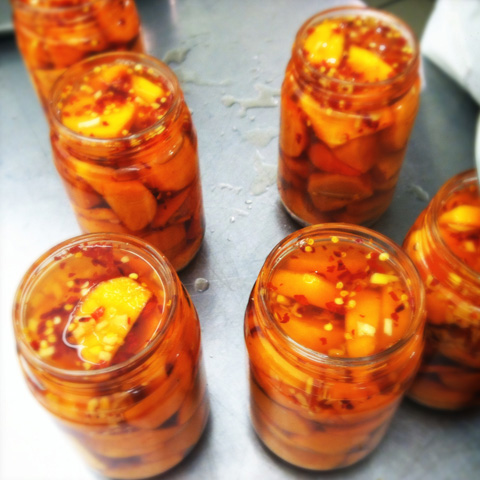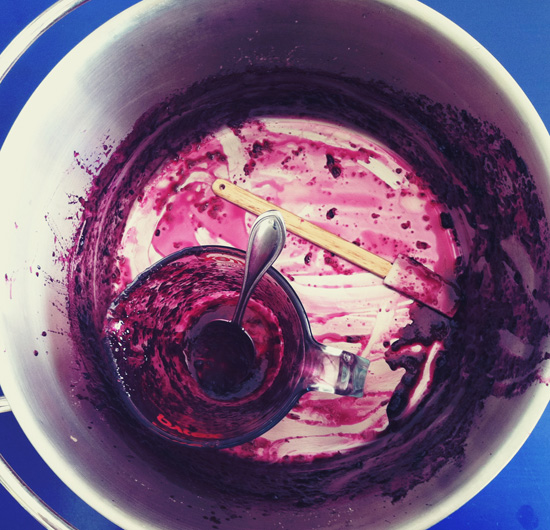Some preserving experts swear by the centuries-old French practice of using unlined copper pans to make the finest preserves. Others swear it off, calling it unsafe. When I outgrew my old 6-quart stockpot, I heard a copper jam pan calling my name, but then I got hung up worrying about poisoning people. (I hate it when that happens.) So is copper safe or not? It took some time to unravel the mystery, and here’s what I learned.
Why Use Copper?
There’s one big reason to use a copper jam pan: You won’t find a better heat conductor anywhere. Great heat conduction equals shorter cooking time — that means you spend less time boiling away the flavor, color, and texture of your fruit.
There are other features of a jam pan that will help you cook your mixtures quickly and evenly, most notably shallowness and slightly flared sides. (The slant helps moisture evaporate; it doesn’t run back into the mixture as with vertical sides.) Copper jam pans have it all.
I admit that I was also caught by the romance of using a gorgeous, heavy copper pan to make my jams. While I was shopping for copper, more than one person said to me, “This pan is something you’ll pass on to your heirs.” I don’t yet know who my heirs will be, but I was intrigued. We’re talking tradition here.
Finally, a good copper pan really lights up the kitchen. For a practice like jam making — as much art as science — investing in a tool that inspires you every day is a legitimate consideration.
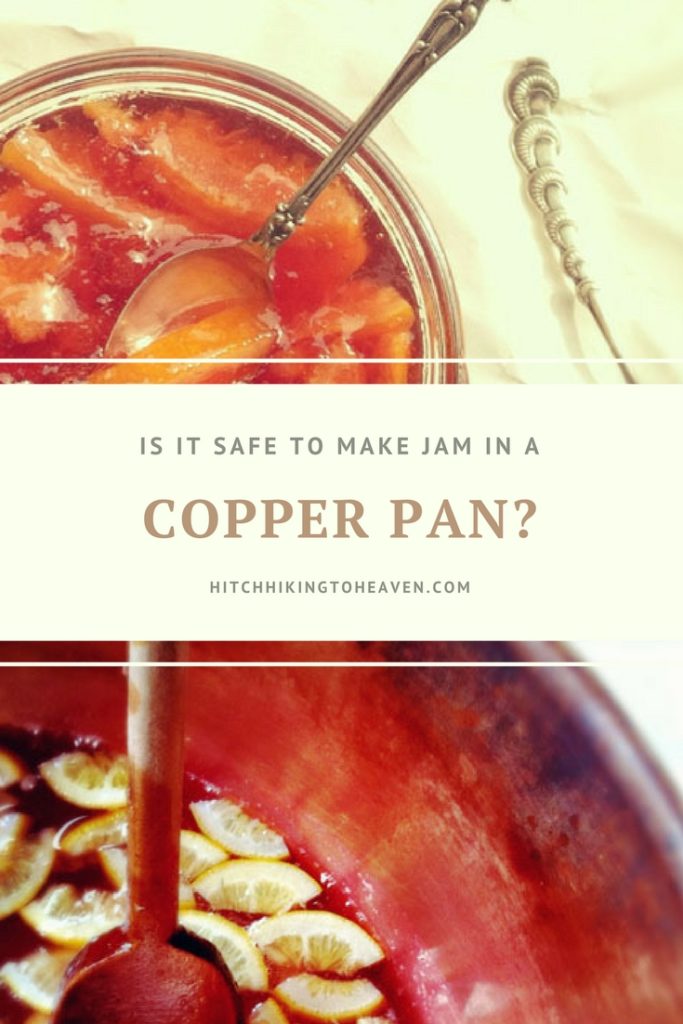
When Copper’s Safe — And When It’s Not
Getting right to the point, an unlined copper pan is safe when you use it to cook a mixture of fruit and sugar. It’s not safe for fruit without added sugar. The road to this conclusion was a long one, and I’ll give you only an abbreviated version of the journey. (I know it doesn’t look abbreviated, but trust me.)
Confession: I somewhat impulsively spent a good chunk of this year’s tax refund on a copper pan without giving a thought to safety. But not long after I made my first batch of copper-pan jam, Stewart started pinging me with little emails about copper toxicity. He’s careful that way.
The more I read about cooking with copper, the more I worried about sickening myself and my loved ones with symptoms like fever, vomiting, and convulsions. (Here’s one source for more than you want to know about how too much copper can screw you up.)
When I turned to my preserving guides to learn more, I got confused. Christine Ferber, in Mes Confitures, states that she always uses a copper pan because of the superior heat conduction. On the other hand, in The Joy of Jams, Jellies, and Other Sweet Preserves (a book I love and use a lot), American expert Linda Ziedrich says copper’s not so smart:
The interior surface of the pan should be made of a substance that won’t react with acidic foods. This excludes iron and aluminum. Although French preserving pans were traditionally made of unlined copper — because copper would react with acid and thereby enhance gelling — such pans are frowned on today, at least in the United States, because copper can be toxic.
What’s the deal? Clearly, copper jam pans have been used for centuries without causing a mass die-off of jam eaters. But fruit is acidic and we know that acid and copper shouldn’t mix. Help!
For the final word, I contacted Rachel Saunders, proprietress of Blue Chair Fruit and maker of jam that the Bay Area is raving about. Rachel herself makes all of Blue Chair’s small-batch preserves in unlined copper kettles — and she had the clearest, most practical answer to my question:
The key to using a copper pan is to put only the jam mixture in it — put the fruit in the pan only after it has been combined with sugar. Putting fruit in the pan on its own will cause the fruit to react with the copper and can be dangerous. I have made thousands of jars in our copper pans, and the results are excellent. The high concentration of sugar in the mixture prevents toxicity.
So there you go. Sugar prevents the acidic reaction. That’s why you should never prepare or macerate your fruit in unlined copper. Use glass or ceramic instead.
The truth about copper was good news and bad news for me. Good, because I can use my new copper pan for lots of preserves. Bad, because some won’t work.
I sometimes make jam with Pomona’s Pectin — a citrus-based pectin that allows you to dramatically cut the sugar in a recipe. The catch is that you add the sugar to the mixture very late. You prep and boil the fruit well before you add the sweet stuff — exactly what you don’t want to do with a copper pan. Boo. I still needed a pan I could use with my Pomona’s recipes. For that, I chose the Demeyere 10.6 Quart Maslin pan — stainless steel with a heavy bottom — which I’ve happily used for many years.
How to Care for a Copper Pan
When it comes to cleaning copper pans, it’s fine to keep things simple. The jam makers I talked to keep their pans clean and dry, but they’re not fussy about a little natural, penny-colored patina.
Rachel Saunders advises rinsing your pan right after you use it, cleaning it with a very mild detergent, and drying it at once. These simple precautions will help to prevent any unwanted reactions. If you do ever notice evidence of oxidation on your pan — a sort of green, mustardy ick, as I understand it — you can use a very gentle scouring pad to get rid of it.
Copper pans can take some abuse. From a safety perspective, there’s no need to worry about some scratches or scorching. Feel free to crank your copper to the highest heat. That’s what it’s made for.
Of course, if you want to keep your pan pristine, there’s lots of information out there about how to do it.
Want Copper? Sources for Your Fix
If copper grabs you like it did me, you’ve got a few choices to make: What brand? What size? How much are you willing to pay?
The brands you can most easily find and order in the U.S. are Mauviel, Matfer Bourgeat, and Baumalu. The smallest pans are around 10 quarts (Matfer makes one of these). None of them are cheap. Matfer is the lightest and least expensive of the bunch — you can find one for a little more than $100 — but keep in mind that lighter weight means lower quality. The super heavy, hammered Mauviel 11.6-quart pan pictured at the top of this post retails for about $270. I found a very nice, new Baumalu 10-quart pan on eBay for $138, shipping included.
A couple of places to start your search:
As with almost everything else on the planet, you can find Mauviel pans on Amazon.
For an interesting assortment of new and used pans, it’s fun to browse eBay. Search for “copper jam.” You may have to sort through a few pairs of copper-colored Nike Space Jam sneakers, but those are the search terms that will bring up the greatest number of copper jam pans, kettles, pots — whatever the seller decides to call them.
If you want to walk into a store, you can usually find the 11.6-quart Mauviel pan in stock at Williams Sonoma or Sur La Table.
Of course, you don’t need copper to make good jam but, without a doubt, a quality pan can enhance your jamming experience. I love my copper pan. I feel almost like it talks to me — offering recognizable sights and sounds to indicate the phases my jam goes through as it cooks, especially when it’s ready to come off the heat. My old, dark pot didn’t provide the same clear signs about what my jam was up to. I say if you want copper and you’re willing to follow a few simple safety and cleaning precautions, go for it.

